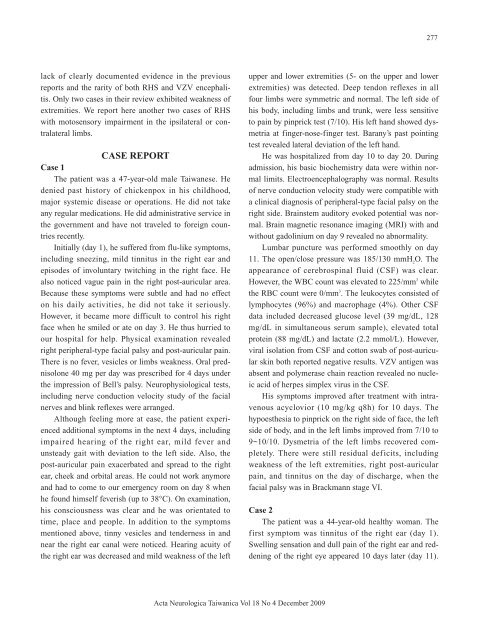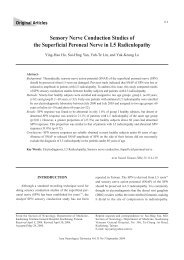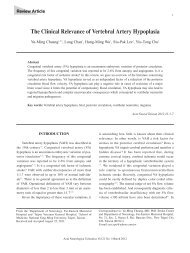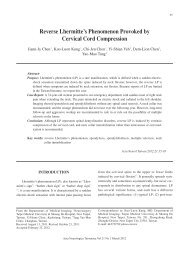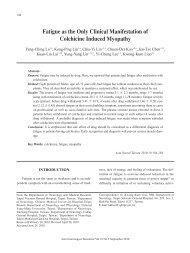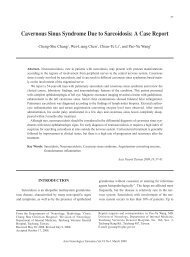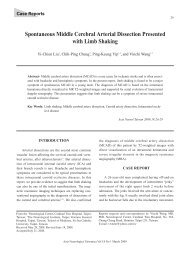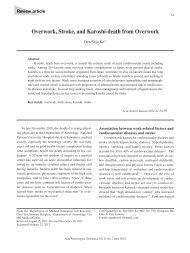Ramsay Hunt Syndrome with Hemiparesis and ... - Vol.22 No.1
Ramsay Hunt Syndrome with Hemiparesis and ... - Vol.22 No.1
Ramsay Hunt Syndrome with Hemiparesis and ... - Vol.22 No.1
Create successful ePaper yourself
Turn your PDF publications into a flip-book with our unique Google optimized e-Paper software.
277<br />
lack of clearly documented evidence in the previous<br />
reports <strong>and</strong> the rarity of both RHS <strong>and</strong> VZV encephalitis.<br />
Only two cases in their review exhibited weakness of<br />
extremities. We report here another two cases of RHS<br />
<strong>with</strong> motosensory impairment in the ipsilateral or contralateral<br />
limbs.<br />
CASE REPORT<br />
Case 1<br />
The patient was a 47-year-old male Taiwanese. He<br />
denied past history of chickenpox in his childhood,<br />
major systemic disease or operations. He did not take<br />
any regular medications. He did administrative service in<br />
the government <strong>and</strong> have not traveled to foreign countries<br />
recently.<br />
Initially (day 1), he suffered from flu-like symptoms,<br />
including sneezing, mild tinnitus in the right ear <strong>and</strong><br />
episodes of involuntary twitching in the right face. He<br />
also noticed vague pain in the right post-auricular area.<br />
Because these symptoms were subtle <strong>and</strong> had no effect<br />
on his daily activities, he did not take it seriously.<br />
However, it became more difficult to control his right<br />
face when he smiled or ate on day 3. He thus hurried to<br />
our hospital for help. Physical examination revealed<br />
right peripheral-type facial palsy <strong>and</strong> post-auricular pain.<br />
There is no fever, vesicles or limbs weakness. Oral prednisolone<br />
40 mg per day was prescribed for 4 days under<br />
the impression of Bell’s palsy. Neurophysiological tests,<br />
including nerve conduction velocity study of the facial<br />
nerves <strong>and</strong> blink reflexes were arranged.<br />
Although feeling more at ease, the patient experienced<br />
additional symptoms in the next 4 days, including<br />
impaired hearing of the right ear, mild fever <strong>and</strong><br />
unsteady gait <strong>with</strong> deviation to the left side. Also, the<br />
post-auricular pain exacerbated <strong>and</strong> spread to the right<br />
ear, cheek <strong>and</strong> orbital areas. He could not work anymore<br />
<strong>and</strong> had to come to our emergency room on day 8 when<br />
he found himself feverish (up to 38°C). On examination,<br />
his consciousness was clear <strong>and</strong> he was orientated to<br />
time, place <strong>and</strong> people. In addition to the symptoms<br />
mentioned above, tinny vesicles <strong>and</strong> tenderness in <strong>and</strong><br />
near the right ear canal were noticed. Hearing acuity of<br />
the right ear was decreased <strong>and</strong> mild weakness of the left<br />
upper <strong>and</strong> lower extremities (5- on the upper <strong>and</strong> lower<br />
extremities) was detected. Deep tendon reflexes in all<br />
four limbs were symmetric <strong>and</strong> normal. The left side of<br />
his body, including limbs <strong>and</strong> trunk, were less sensitive<br />
to pain by pinprick test (7/10). His left h<strong>and</strong> showed dysmetria<br />
at finger-nose-finger test. Barany’s past pointing<br />
test revealed lateral deviation of the left h<strong>and</strong>.<br />
He was hospitalized from day 10 to day 20. During<br />
admission, his basic biochemistry data were <strong>with</strong>in normal<br />
limits. Electroencephalography was normal. Results<br />
of nerve conduction velocity study were compatible <strong>with</strong><br />
a clinical diagnosis of peripheral-type facial palsy on the<br />
right side. Brainstem auditory evoked potential was normal.<br />
Brain magnetic resonance imaging (MRI) <strong>with</strong> <strong>and</strong><br />
<strong>with</strong>out gadolinium on day 9 revealed no abnormality.<br />
Lumbar puncture was performed smoothly on day<br />
11. The open/close pressure was 185/130 mmH 2<br />
O. The<br />
appearance of cerebrospinal fluid (CSF) was clear.<br />
However, the WBC count was elevated to 225/mm 3 while<br />
the RBC count were 0/mm 3 . The leukocytes consisted of<br />
lymphocytes (96%) <strong>and</strong> macrophage (4%). Other CSF<br />
data included decreased glucose level (39 mg/dL, 128<br />
mg/dL in simultaneous serum sample), elevated total<br />
protein (88 mg/dL) <strong>and</strong> lactate (2.2 mmol/L). However,<br />
viral isolation from CSF <strong>and</strong> cotton swab of post-auricular<br />
skin both reported negative results. VZV antigen was<br />
absent <strong>and</strong> polymerase chain reaction revealed no nucleic<br />
acid of herpes simplex virus in the CSF.<br />
His symptoms improved after treatment <strong>with</strong> intravenous<br />
acyclovior (10 mg/kg q8h) for 10 days. The<br />
hypoesthesia to pinprick on the right side of face, the left<br />
side of body, <strong>and</strong> in the left limbs improved from 7/10 to<br />
9~10/10. Dysmetria of the left limbs recovered completely.<br />
There were still residual deficits, including<br />
weakness of the left extremities, right post-auricular<br />
pain, <strong>and</strong> tinnitus on the day of discharge, when the<br />
facial palsy was in Brackmann stage VI.<br />
Case 2<br />
The patient was a 44-year-old healthy woman. The<br />
first symptom was tinnitus of the right ear (day 1).<br />
Swelling sensation <strong>and</strong> dull pain of the right ear <strong>and</strong> reddening<br />
of the right eye appeared 10 days later (day 11).<br />
Acta Neurologica Taiwanica Vol 18 No 4 December 2009


